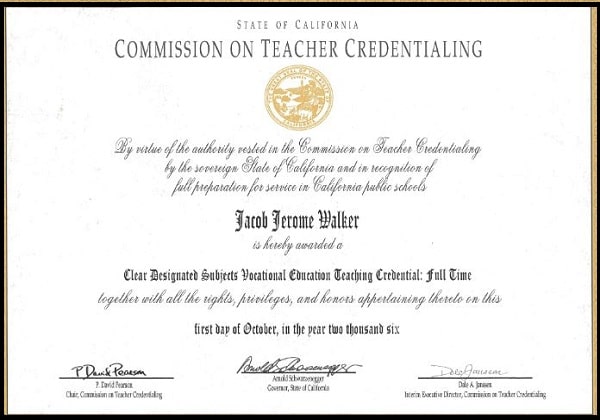Ever dreamed of making a difference in young minds? California welcomes passionate individuals like you into the rewarding world of education. But before you step into your classroom, you’ll need to navigate the process of obtaining a teaching credential. Do you know How to Get a Teaching Credential in California? Don’t worry, this guide will equip you with the knowledge to confidently embark on your journey.
What is a Teaching Credential?
A teaching credential, also known as a teaching license, is a formal document issued by the state that qualifies you to teach in public schools. It’s essentially a permission slip that verifies you have the knowledge, skills, and training necessary to be an effective educator.
Importance of a Teaching Credential:
A teaching credential holds significant importance for several reasons:
- Legality and Employment: In most states, including California, a teaching credential is legally required to be a public school teacher. Schools cannot hire educators without the proper certification.
- Knowledge and Skills: Credential programs equip you with the knowledge and skills needed to be an effective teacher. They cover pedagogy (teaching methods), subject area expertise, classroom management, and student assessment.
- Student Success: Studies show a correlation between teacher qualifications and student achievement. A well-trained teacher creates a positive learning environment and uses effective strategies to help students reach their full potential.
- Career Advancement: A teaching credential opens doors to more career opportunities. It increases your chances of getting hired, can lead to higher salaries, and qualifies you for leadership positions within schools.
- Professional Recognition: Holding a credential signifies that you’ve met professional standards and are committed to the teaching profession. It demonstrates your dedication to student learning and the educational field.
In essence, a teaching credential ensures you have the necessary qualifications to be a successful educator and contribute positively to the lives of your students.
How to Get a Teaching Credential in California?
Building the Foundation: Degrees and Programs
The cornerstone of becoming a California teacher is a bachelor’s degree. While any major is acceptable, some programs offer built-in pathways to teaching credentials, saving you time and streamlining the process.
Choosing Your Credential: Multifaceted or Subject-Specific?
California offers two main credential types:
- Multiple Subject Teaching Credential: This qualifies you to teach grades K-8, encompassing various subjects.
- Single Subject Teaching Credential: This allows you to teach a specific subject (e.g., Math, Science, English) in middle or high school.
Take the CBEST and CSET
Demonstrating your basic skills is essential. You’ll need to pass the California Basic Educational Skills Test (CBEST). Depending on your chosen credential, you might also tackle the California Subject Examinations for Teachers (CSET) specific to your subject area.
Experience Counts: Teach the Students
Theory is valuable, but practical experience is irreplaceable. Prepare for the real classroom by completing a student teaching program. This allows you to hone your skills under the guidance of a mentor teacher.
Background Check: Ensuring a Safe Learning Environment
Undergoing a fingerprint-based background check is mandatory to ensure the safety of students. Undergo a fingerprint-based background check to ensure your suitability for working with children. Demonstrate your understanding of the U.S. Constitution by passing a test or completing approved coursework.
Issuing Your Credential
Once you’ve fulfilled all requirements, the California Commission on Teacher Credentialing (CTC) will grant you your preliminary credential. This allows you to begin teaching while fulfilling coursework to earn a clear credential.
Read also more related topics: Does Substitute Teaching Count towards Years of Service?
How Long Does A Teaching Certificate Take To Get?
Is It Hard to Get a Teaching Certificate?
Alternative Ways to Get Teaching Credential in California
The traditional path to a teaching credential involves a university program and student teaching. However, California recognizes the value of diverse experiences and offers alternative pathways for those with strong qualifications and a passion for teaching. Here’s a breakdown of these alternative routes:
- University Internship Programs: These programs combine coursework with supervised teaching experience, allowing you to begin teaching sooner while completing your credential requirements. Links to go official California sites: https://www.calstate.edu/
- School Internship Programs: Partner with a school district to gain valuable in-classroom experience under the guidance of a mentor teacher. These programs often culminate in a teaching credential upon successful completion.
- Private School Teaching Experience: If you have experience teaching at a private school in California for a minimum amount of time (requirements vary), you may be eligible for a credential through the Private School Credential Program.
- Peace Corps Teaching Experience: Prior Peace Corps service can be leveraged to obtain a California teaching credential. Your overseas teaching experience combined with additional coursework can pave the way for certification.
Important Factors to Consider:
- Each alternative pathway has specific requirements and eligibility criteria. Be sure to research the details associated with your chosen program on the CTC website ([CA Commission on Teacher Credentialing]).
- Subject matter expertise is still crucial. You might need to pass additional subject-specific exams (CSET) even through an alternative route.
- While these programs offer a faster track, they may not be as widely available as traditional programs. Research options in your area.
Benefits of Alternative Credentials:
- Faster Entry into Teaching: These programs can expedite your path to the classroom compared to traditional routes.
- Leveraging Existing Experience: Your prior teaching experience, whether in private schools or the Peace Corps, becomes an asset.
- Flexibility: Some programs offer online or hybrid options, catering to busy schedules.
Regardless of the path you choose, a commitment to student learning and a passion for education are essential qualities for a successful teacher in California.
This is just the first chapter! California offers various resources and support programs to guide you throughout your teaching career.
Are you ready to take the first step? Explore teacher preparation programs in California, research your desired credential type, and start preparing for the required exams. With dedication and the right resources, you’ll be well on your way to making a lasting impact in the lives of California’s students.
Can I Use My California Teaching Credential in Other States?
Here’s a concise guide on using your California Teaching Credential in other states:
- Understand Reciprocity:
- Reciprocity refers to the process of recognizing teaching credentials from one state in another state.
- While some states have agreements that facilitate this process, it’s essential to research the specific requirements of your target state.
- NASDTEC Interstate Agreement:
- The National Association of State Directors of Teacher Education and Certification (NASDTEC) plays a crucial role.
- NASDTEC agreements allow compact agencies to verify a teacher’s license status across states.
- However, remember that states may still have their unique requirements.
- California’s Approach:
- California offers reciprocity with 45 states, including Arizona, Hawai’i, Texas, and New York.
- To transfer your California credential, ensure you meet the subject matter criteria for your credential area.
- Research Your Target State:
- Investigate the specific requirements of the state where you plan to teach.
- Be prepared to fulfill any additional criteria while teaching on a temporary or provisional license.
Final Note
In conclusion, we can say that earning a teaching credential in California unlocks a rewarding career path where you can make a tangible difference in the lives of young people. By following the steps outlined above, from choosing the right program to demonstrating your knowledge, you’ll be well on your way to becoming a certified educator in the Golden State.
This journey requires dedication, but the rewards of shaping young minds and fostering a love for learning are truly immeasurable. So, if you possess a passion for education and a desire to inspire the next generation, take the first step today on your path to a fulfilling teaching career in California.


